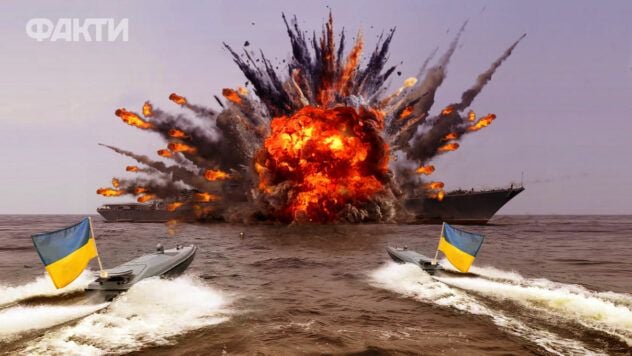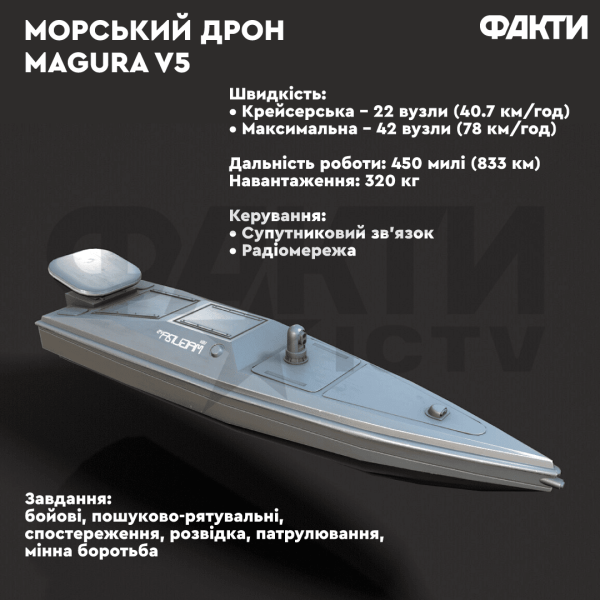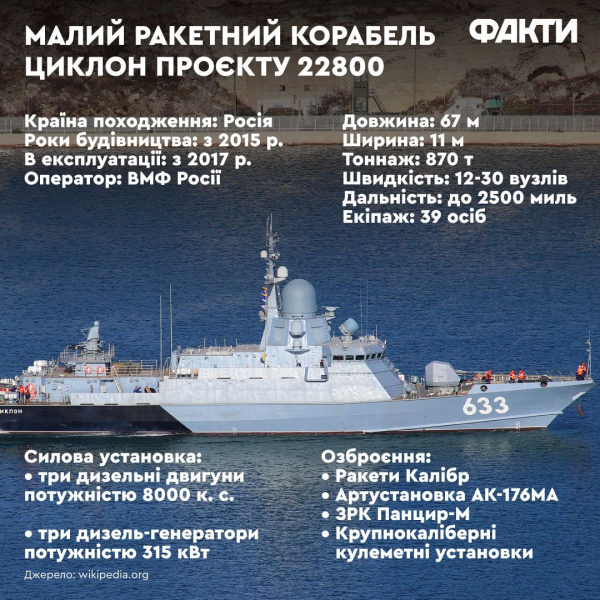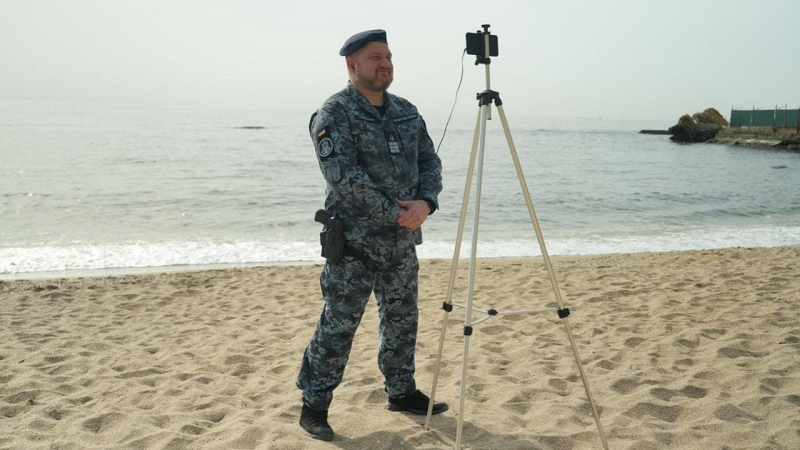
Sunday, July 6, marks the Day of the Naval Forces of the Armed Forces of Ukraine. This is a professional holiday for servicemen and employees of the Ukrainian Navy, who bring Ukraine's victory closer every day.
One of the most important developments of specialists in cooperation with the Ukrainian Navy are sea drones, which have radically changed the conduct of military operations.
How have naval drones affected warfare at sea and whether they have a future? Read on in the ICTV Facts article.
Now watching
What are sea drones
Marine drones are mobile devices that can be operated by remote control. They are able to analyze the environment using sensors and even navigate independently.
Unmanned vessels, also known as drone boats or sea drones, have had a wide range of applications for years, including scientific research, search and rescue, surveillance, and coastal patrols.
They are equipped with modern GPS and cameras, which allows marine drones to record everything that happens around on the water.
One of them is the Magura V5 naval drone , which Ukraine used in the Black Sea to attack Russian targets.

Magura is 5.5 m long, has a range of up to 800 km, 60 hours of autonomous operation and can carry several hundred kg of explosives. It transmits real-time video to operators who control the marine drone remotely.
Another drone, larger than Magura, called Sea Baby, can carry 850 kg of explosives. The drone reaches a maximum speed of 90 km/h and can cover a distance of 1,000 km.
How Naval Drones Impacted Warfare
Ukrainian naval drones have revolutionized naval warfare in recent years, relentlessly harassing Russian ships on the high seas and even at naval bases.
Unmanned boats are used to destroy Russian targets in the Black Sea. With the help of sea drones, Ukraine has sunk and damaged a number of Russian ships.
Among them are the missile ship Cyclone of project 22800, the carrier of the cruise missiles Caliber Sergey Kotov, the large landing ship Novocherkassk and others, which were in service with the Black Sea Fleet of the Russian Navy. This helped Kyiv to restore part of the grain exports, which were blocked by the Russian Federation.

In total, a third of the Russian fleet's ships have already been put out of action. They have been destroyed or damaged, some of them have already been repaired, Ukrainian Navy spokesman Dmitry Pletenchuk said in June 2024.
In particular, on the night of December 6, 2024, the Security Service of Ukraine carried out a raid in the Kerch Bay with Sea Baby marine drones, which can carry up to 1,000 kg of payload over 1,000 km.
Then a group of naval UAVs entered into combat with Russian helicopters, aircraft and Raptor patrol boats. According to the SBU, they managed to significantly damage the helicopters and hit a barge that was transporting military equipment and equipment for repairing the Crimean Bridge.
The Sea Baby sea drones can carry various weapons: both multiple launch rocket systems and flying drones and large-caliber machine guns, the SBU noted. Modern Sea Baby sea drones differ significantly from the first models.
On December 31, 2024, Magura V5 naval drones, which are equipped with missiles, destroyed two Russian Mi-8 helicopters and shot down another one in the Black Sea near the temporarily occupied Crimea.
On May 2, the Main Intelligence Directorate of the Ministry of Defense of Ukraine shot down a combat aircraft for the first time with a naval drone. The Main Intelligence Directorate confirmed the downing of two Russian Su-30 multirole fighters with AIM-9 Sidewinder infrared-guided air-to-air missiles fired from a Magura V7.
On May 19 , it became known that Ukrainian sea and air drones destroyed the Russian Neva radar system, warehouses and a residential block on a gas production platform in the Black Sea, the so-called Boyko rigs.
According to the SBU, first one tower was attacked by a drone from the air, and then by a naval drone. As a result, the Neva radar, which the Russian troops used to monitor the situation in the air and on the water, was destroyed.
With each use, naval drones are improved and modernized to further hit enemy targets. In May 2025, the Main Intelligence Directorate of the Ministry of Defense presented new models of Magura attack naval drones. Among them:
- Magura V5;
- Magura V6P multifunctional platform;
- the Magura V7 rocket-launching drone, which destroyed an enemy combat aircraft for the first time in history;
- Magura V7 model, equipped with a combat machine gun module.
In the period from 2023 to 2024, the Main Intelligence Directorate of the Ministry of Defense of Ukraine destroyed 15 units from the ship and boat composition of the Russian Black Sea Fleet – landing, patrol and reconnaissance ships, landing and high-speed boats.
Thanks to the strikes of sea drones, it was possible to send to the bottom of the Black Sea:
- missile boat Ivanovets;
- landing craft D-295 Akula;
- landing craft D-144 Serna;
- large landing ship Caesar Kunikov;
- speedboat KS-701 Tuna;
- two Reef-75 speedboats;
- Patrol ship Sergei Kotov with a Ka-29 helicopter on board.
Conducting war at sea
The spokesman for the Ukrainian Naval Forces, Dmitry Pletenchuk, told ICTV Fakty that naval drones have indeed changed the course of the war, but one should not expect that they can become a magical solution to all the existing problems in the waters of the Azov-Black Sea region that are associated with the presence of the enemy.
— We also won’t be able to solve many current issues of ensuring the safety of civilian shipping, control of waters and straits with drones. One way or another, drones have certainly changed the course of this war. And they have greatly influenced the balance of power. You see that the enemy is now forced to hide at one of its military bases in the Black Sea — Novorossiysk, — said Dmitry Pletenchuk.
That's why Russian ships are staying away from the Ukrainian coast and limiting their time in the open sea. Launches of Kalibr cruise missiles from ships in the Black Sea are now a rarer occurrence than they used to be.
At the same time, Dmitry Pletenchuk emphasized that “war is a search for solutions,” and “technology is a search for new ideas.”
“Our problem is that every time we have to find new ways to use the existing weapons systems, in particular, drones. They solved these problems at one of the first stages of liberating our waters from the presence of Russian warships. This problem was solved, for example, by the coastal missile and artillery troops of the Navy,” he explained.
According to the spokesman for the Ukrainian Navy, the impact of drones on the situation in the maritime area is serious, but “this method will not allow us to completely solve all the problems.”
Ukraine is, in principle, now a world leader in the use of unmanned and unmanned naval systems, as well as their combat use – this is a fact, emphasized Dmitry Pletenchuk.
The future belongs to unmanned systems
– Of course, we look to the future, and there we see most combat systems – unmanned. These are drones, which in the air, in particular, the Navy uses, for example, the same Bayraktar.
But full-fledged and full-size ships that will perform a wider range of tasks assigned to the Navy of any country are a distant prospect to allow the production and operation of completely unmanned ones, the Navy spokesman noted.

Photo: Dmitry Pletenchuk
Dmitry Pletenchuk noted that there is a large list of tasks that ships must perform. In particular, patrolling, demining, air defense and counter-sabotage work, which cannot be delegated exclusively to drones.
— We will not be able to transfer all these functions exclusively to drones, at least based on their size, because some equipment is still large. For example, anti-ship missiles, which cannot be placed on a drone. This is a demining team with the appropriate equipment, which is quite large purely physically. Our future is the full-fledged development of the Naval Forces in their classical form, — the spokesman for the Ukrainian Navy emphasized.
The experience of Ukraine is, of course, considered by all countries that have any maritime interests in the world's oceans, noted Dmitry Pletenchuk.
This applies to both states that are allies of Ukraine, and to countries that are not allies.
— The experience of application, planning of operations, their execution is studied by many countries, as well as technological solutions. I can say that there is interest, — noted Pletenchuk.
The Potential of Marine Drones
At the end of the last century, technological innovations in the field of unmanned vessels expanded their potential for use.
The deadly, advanced maritime drones developed and used by Ukraine during its war with Russia have opened a new chapter in that story, AP News reports.
Ukraine became the first country to create a separate division engaged in the production of sea drones.

Ukrainian sea drones. Photo: United24
— Ukraine has become a producer of new military technologies, and sea drones should become an integral part of the combat toolkit in the war of the 21st century. Behind the development of a new generation of sea drones, Ukrainian drones are know-how and ingenuity, — the article says.
Marine drones are not cheap. For example, one Magura costs about $250,000, and the new Sea Baby costs about $221,000. But they can damage or sink a ship worth hundreds of millions of dollars.
Military expert Alexey Getman told ICTV Fakty that the modernization and use of Ukrainian naval drones is a positive moment for us, but a negative one for the Russians.
“We have started to modernize our sea drones, which initially attacked exclusively sea targets. Now it is a platform that can quietly creep up on enemies. Of course, it can strike helicopters and other targets, particularly air targets,” he noted.
Getman suggested that the further use of sea drones has very good prospects, because even now they can attack certain objects not only on the water, but also on the coast.
“I think that we will soon see not only surface drones, but also underwater ones. There are talks that we are making attempts regarding drones that will not only float on the surface, but also dive. Not very deep, because it is not exactly a submarine, but dive anywhere,” he noted.
A military expert has suggested how sea drones could be upgraded. He believes they could increase their payload capacity and carry more explosives.
— Surface drones are very promising. It can be added that this is the first case in history when sea drones managed to drive away a fairly powerful Russian Black Sea fleet to Novorossiysk. The future of this war is drones that not only fly and swim, but also walk on land. This is already turning into a drone war, — Alexey Getman summed up.

